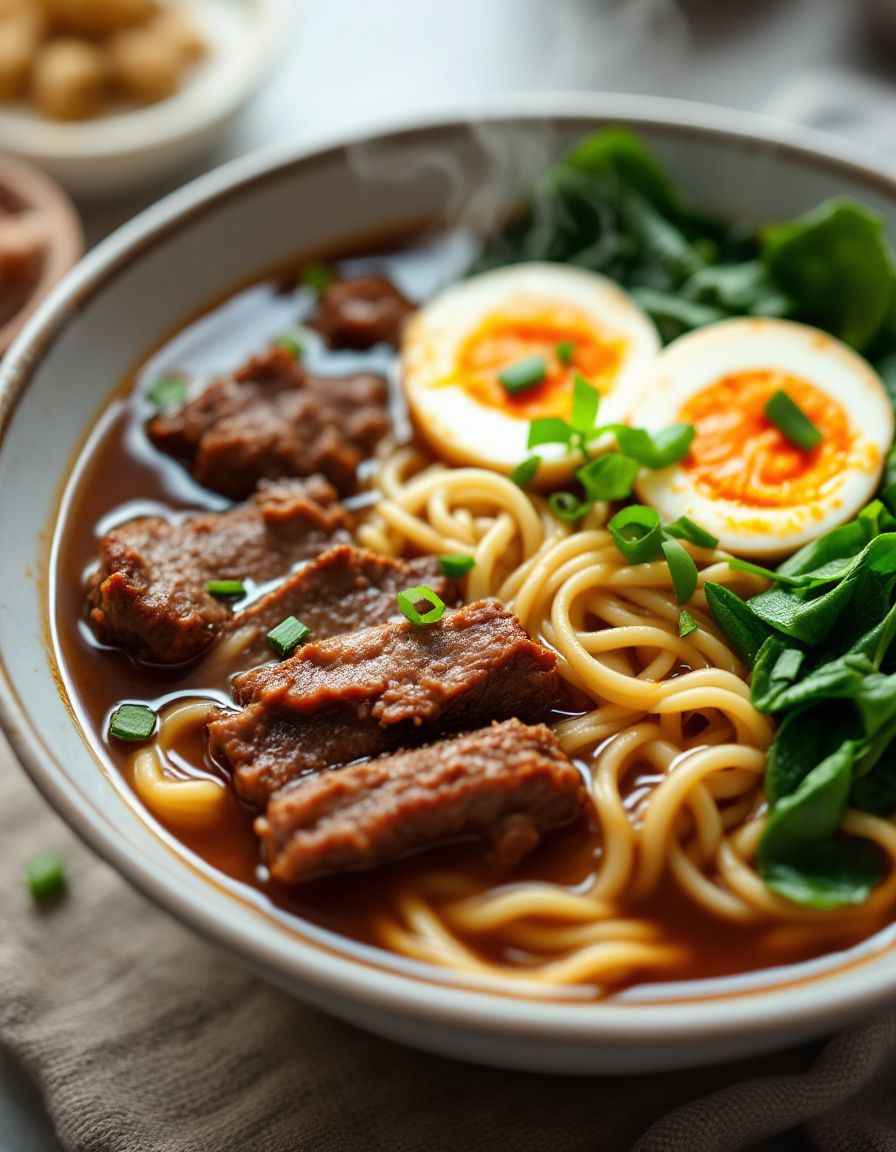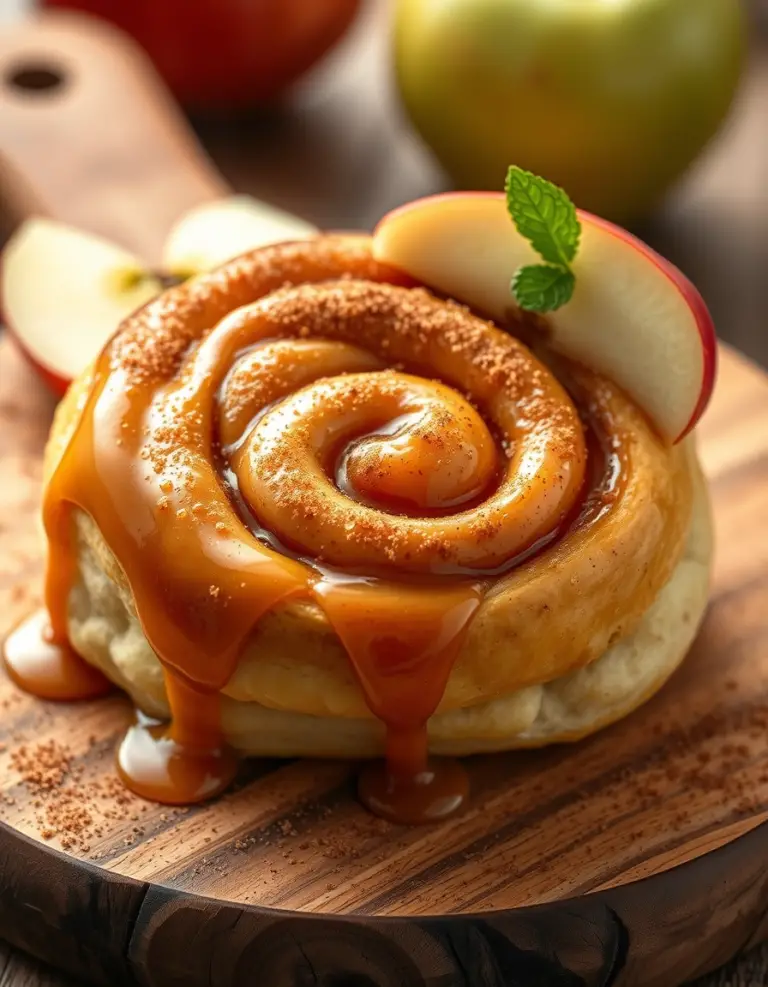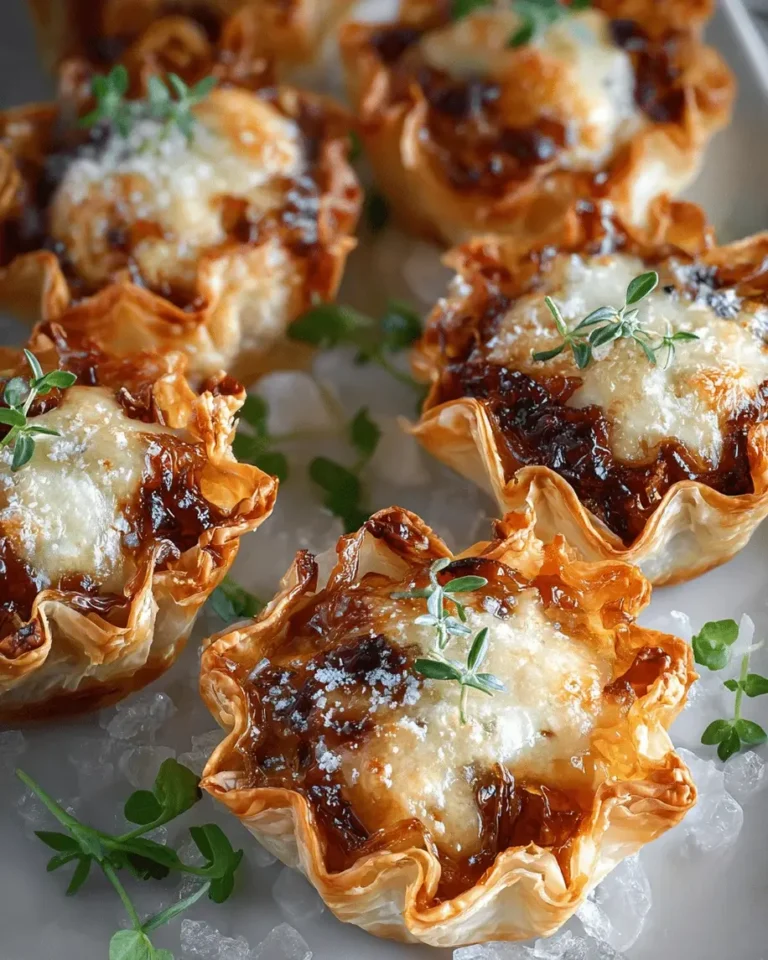Easy Slow Cooker Beef Ramen – Flavorful Family Favorite

Slow Cooker Beef Ramen: Cozy, Flavorful & Effortless!
Indulge in the heartwarming flavors of our Slow Cooker Beef Ramen, a dish that effortlessly marries comfort and convenience. This delightful bowl of noodles is sure to warm you up with its rich broth and tender beef, making it a perfect choice for a cozy evening or a family gathering. Infused with aromatic spices, the flavors meld beautifully as it simmers throughout the day, filling your home with a mouthwatering scent. The beauty of this recipe is that it offers a delicious meal with just a few simple ingredients and minimal hands-on time.
Imagine the broth, simmered to perfection, enveloping soft noodles and melt-in-your-mouth beef. Each spoonful brings a delightful balance of savory and umami flavors that linger on your palate, inviting you to savor every bite. Whether you’re enjoying a quiet night alone or hosting friends, this Slow Cooker Beef Ramen effortlessly elevates your dining experience, providing warmth and satisfaction in every bowl.
Quick Recipe Highlights
- Flavor Profile: A deep, salty umami flavor paired with hints of ginger and sesame create a delightful balance.
- Texture: The tender beef melts in your mouth, while the noodles offer a comforting chewiness.
- Aroma: A fragrant blend of garlic, ginger, and soy sauce releases a warm, inviting scent.
- Visual Appeal: Rich brown broth with vibrant green scallions and a splash of exotic colors from toppings.
- Skill Level Needed: Perfect for beginners, as it requires minimal cooking skills.
- Special Equipment: A slow cooker is the only specialized equipment needed for this effortless recipe.
Recipe Overview
- Difficulty Level: This Slow Cooker Beef Ramen is marked as easy, making it accessible for all home cooks, whether novice or experienced. Its simplicity lies in the method of cooking; on busy days, it allows you to prepare a hearty meal without much time spent in the kitchen.
- Category: This dish serves as a satisfying main course, perfect for a warming dinner after a long day or as a feature at gatherings.
- Cuisine: Drawing from traditional Japanese cuisine, ramen is beloved worldwide, and this recipe brings those authentic flavors into your home kitchen.
- Cost: With budget-friendly ingredients, this dish can be made without breaking the bank, making it a great option for families.
- Season: Ideal for fall and winter months when comfort food is most desired, this dish warms both body and soul.
- Occasion: Enjoy it on chilly evenings, for game day, or during casual get-togethers with friends.
Why You’ll Love This Recipe
The Slow Cooker Beef Ramen is a symphony of taste and texture that will captivate your senses. The balance of flavors comes from slowly simmering beef and aromatics, creating a broth that is both savory and comforting. Each ingredient serves a purpose, leading to a wholesome meal that stands out while being incredibly easy to prepare. The melt-in-your-mouth beef paired with perfectly cooked noodles showcases a delicious marriage of richness and heartiness.
In terms of convenience, this recipe offers the ultimate ease of preparation. Simply add the ingredients into your slow cooker in the morning and let it work its magic! After a long day, come home to the delicious aroma that fills your house, and sit down to a nourishing meal without stress. This dish not only saves time but also allows you to enjoy a homemade meal with virtually no fuss.
From a nutritional standpoint, this beef ramen is packed with protein, vitamins, and minerals from the broth and vegetables. The balance of ingredients ensures you receive essential nutrients in each bowl, making it a wholesome option for families. You can also customize the dish to boost its nutritional value by adding more vegetables or swapping in leaner cuts of beef.
Socially, serving this ramen can elevate gatherings or casual dinners. It encourages sharing and enjoying a relaxed meal together, with friends and family gathering around the table. The rustic nature of this dish invites you to dive in with chopsticks or a fork, making it a great communal dish for potlucks or family nights.
Finally, its affordability makes it a winner. The low-cost ingredients mean that you can serve up a delicious meal that satisfies a crowd without spending a fortune. This recipe is not only delicious but also a practical choice for any household.
Historical Background and Cultural Significance
Ramen has an intriguing history rooted in Chinese noodle dishes that took on a unique identity in Japan. Over the years, it has evolved into various styles, each reflecting regional flavors and local ingredients. Slow cooker versions provide a contemporary spin on traditional recipes, making it accessible regardless of cooking skill. This adaptation aligns with modern time constraints while paying homage to an age-old favorite.
The cultural importance of ramen is profound, as it symbolizes comfort and community in Japan. Ramen shops are ubiquitous, often serving as local meeting places for people. This dish reflects the heart and soul of Japanese cuisine, where the love of food is celebrated. Sharing a bowl of ramen is often associated with warm gatherings and a sense of belonging.
As the recipe for ramen has traveled across borders, it has adapted to various tastes and preferences, leading to exciting twists that make it loved around the world. In the realm of home cooking, slow cooker beef ramen brings a slice of this culture into your kitchen, making for a heartfelt meal that bridges different culinary traditions.
Finally, regional variations abound in ramen preparation. From the tonkotsu broth of Kyushu to the shio ramen of Hakodate, each variety tells a story of local flavor and preference. By making slow cooker beef ramen, you’re not just enjoying a meal; you’re participating in this rich culinary narrative.
Ingredient Deep Dive
- Beef: An essential ingredient in ramen, quality beef brings richness and depth to the broth. Typically, tougher cuts such as chuck roast are preferred as they become perfectly tender when slow-cooked. Beef is also a great source of protein and important nutrients, such as iron and B vitamins. When buying beef, look for marbling, which indicates flavor, and choose cuts that suit your cooking method. For storage, keep in the refrigerator for up to three days or freeze for longer shelf life. If you’re looking to substitute, pork or chicken can be good alternatives.
- Noodles: Ramen noodles are integral to the dish, providing the soothing, chewy texture that complements the rich broth. Made from wheat flour, they absorb flavors beautifully and provide a filling component to the meal. Look for fresh or frozen noodles for the best taste; dried noodles are also available but may require adjustments in cooking time. Store uncooked ramen noodles in a cool, dry place. If gluten is a concern, explore gluten-free noodle options for a suitable substitute.
- Broth Base: The broth, often the heart of ramen, traditionally combines stock with soy sauce and other umami-enhancing ingredients. The savory flavors stem from the careful selection of stocks, whether homemade or store-bought. Homemade broth enhances taste and nutrition, but if pressed for time, high-quality store-bought versions can be used. For storage, refrigerate broth for up to a week or freeze in portions. If you need a non-soy version, use miso or coconut aminos as flavorful alternatives.
- Aromatics: Components like garlic, ginger, and scallions provide the essential aromatic foundation for ramen. These ingredients not only boost flavor but also offer various health benefits, including anti-inflammatory properties. For the best freshness, buy them whole and store in a cool, dry place. If you’re out of fresh varieties, dried versions can be useful substitutes, although adjustments in amounts may be necessary.
Common Mistakes to Avoid
- Not browning the beef: Skipping this step can lead to a less flavorful broth. Searing the beef enhances flavors and adds depth to the dish.
- Using overcooked noodles: Making sure to add noodles to the broth at the right time will prevent them from becoming mushy. Give them just enough time to soak in the flavors while keeping their texture.
- Ignoring seasoning: Taste your broth before serving; adding salt or soy sauce can elevate the flavor. Adjusting at the end is often necessary.
- Skipping garnishes: Fresh toppings like scallions, egg, or nori add freshness, flavor, and texture, so don’t skip this step!
- Overcooking the broth: Although a slow cooker is forgiving, cooking too long can result in a bitter taste. Follow the recipe’s cook time for optimal results.
- Not layering flavors properly: Add ingredients at different intervals for maximum flavor infusion into the broth. Depending on the ingredient, some may need a longer cooking time than others.
- Not using enough liquid: Ramen should have a broth that covers the noodles and meat adequately. Ensure your slow cooker has enough liquid to keep everything submerged.
- Improper storage: Allowing leftovers to cool before refrigerating can lead to spoilage; always store safely. Also, be mindful of how long to keep in the fridge or freezer.
Essential Techniques
- Searing meat: This crucial technique develops rich flavors in the beef, contributing to a deeply savory broth. To master it, ensure the pan is hot and avoid overcrowding the meat, which can cause steaming instead of searing. Look for a deep brown crust as your indicator of success.
- Slow cooking: Understanding the benefits of low and slow cooking is key. This method allows tough cuts of meat to break down and become tender, enhancing broth flavors. Visual cues include bubbling broth and a warm kitchen aroma; it’s perfect when you can set and forget.
- Thickening broth: If desired, you can thicken your broth with a cornstarch slurry or miso. Master this by mixing starch with cold water before adding it to the warm broth; this prevents lumps. Watch for a glossy finish as your cue for success.
- Balancing flavors: It’s essential to taste and adjust seasonings throughout the cooking process. Build your flavors gradually by adding soy sauce, salt, or lime juice bit by bit. The goal is to find the perfect balance that enhances but does not overpower your dish.
Pro Tips for Perfect Slow Cooker Beef Ramen
– Use fresh, high-quality ingredients to enhance overall flavor. Organic vegetables and locally sourced beef will make a noticeable difference.
– For deeper flavor, allow the broth to sit overnight; this maturation process can enhance all the taste profiles.
– Consider using a combination of different beef cuts (e.g., brisket or shank) for a variety of textures and richness.
– Customize your ramen to your taste by incorporating seasonal vegetables such as bok choy or mushrooms during the last hour of cooking.
– Experiment with different toppings, including pickled ginger, sesame seeds, or soft-boiled eggs for an authentic finish.
– Always let your ramen cool slightly before serving to allow the flavors to meld together; hot broth will hide nuances.
– Don’t hesitate to add a splash of rice vinegar before serving; it adds a bright note that elevates the dish.
– Use a variety of noodles to discover which ones you prefer; consider egg noodles for a richer taste or rice noodles for a gluten-free option.
Variations and Adaptations
You can find endless ways to adapt and modify this Slow Cooker Beef Ramen to suit your preferences. Regionally, variations abound; in Hokkaido, for example, they often use a rich miso base alongside corn and butter, while in Nagoya, a thicker, rich broth is preferred. These adaptations showcase the diversity within ramen culture and allow you to explore new flavors.
Seasonal adaptations could mean incorporating fresh local produce such as peas or carrots in the spring, or root vegetables like sweet potatoes during the winter months. Adding seasonal ingredients not only improves the flavor but also offers nutritional benefits relevant to each time of year.
For dietary modifications, feel free to use a leaner protein option like chicken or a plant-based alternative such as tofu or tempeh, which can align well with vegan or vegetarian diets. This approach ensures you maintain the essence of the dish while accommodating preferences.
Flavor variations can result from adjusting the base components. Introducing spices such as sriracha or chili paste can provide an exciting heat element, or consider enhancing the umami flavor profile with shiitake mushrooms or kelp in the broth.
Texture modifications could involve using spiralized vegetables like zucchini or carrots in place of traditional noodles for a lighter, low-carb option. This could appeal to health-conscious eaters or those looking to reduce their carbohydrate intake.
Finally, presentation alternatives can play a big role in elevating your dining experience. Serve the ramen in colorful bowls, garnished with fresh herbs or edible flowers for a beautiful visual appeal that impresses guests.
Serving and Presentation Guide
Presenting your Slow Cooker Beef Ramen can be as delightful as preparing it. Begin with a shallow, wide bowl to allow the vivid colors of your dish to shine. Layer the noodles in the bottom, then ladle the beef and broth carefully over them to minimize breakage. Garnishing is crucial, so consider thinly chopped scallions, a sprinkle of sesame seeds, and a dash of chili oil for added flavor and visual impact.
Traditional accompaniments such as nori strips or pickled vegetables provide a delightful contrast, both visually and texturally. For modern serving suggestions, consider adding a soft-boiled egg atop each bowl, where the creamy yolk can enrich the broth.
Temperature is key; serve the ramen hot, allowing guests to enjoy its warmth fully. If you plan to make larger batches for sharing, hold the broth and noodles separately until ready to serve to maintain the best textures.
Additionally, consider portion control; a generous serving of noodles complemented by equal parts broth and topping can offer a satisfying yet balanced dish. This ensures everyone has enough without overwhelming their appetites.
Wine and Beverage Pairing
When it comes to wine pairings for Slow Cooker Beef Ramen, consider a fruity red wine such as a Pinot Noir, which balances well with the umami profile of the dish. The light body and acidity match the hearty flavors without overpowering them, allowing the dish to shine.
For non-alcoholic alternatives, you can serve a sparkling water with a hint of lime. The fizz provides a nice contrast to the warm broth and helps cleanse the palate between bites.
If you enjoy tea, opt for a robust green tea or even a light herbal blend, which can enhance the meal and add a refreshing complement to the richness of the ramen.
Temperature considerations are essential when serving beverages alongside ramen; both should be served at optimal temperatures to enrich the dining experience.
Storage and Shelf Life
Proper storage of your Slow Cooker Beef Ramen will ensure you can enjoy it again later. Once cooled, transfer any leftovers to airtight containers and refrigerate, where they will last for up to three days. For longer shelf life, consider freezing portions in freezer-safe bags or containers, which can remain good for up to three months.
For those stored in the refrigerator, look out for signs of spoilage such as off-smells or changes in color. When reheating, do so slowly on the stovetop or in the microwave until heated through—avoid letting it boil to maintain texture.
Keep in mind that noodles can absorb broth as they sit, so store them separately if possible if you want to extend the freshness of each component.
Make Ahead Strategies
Making your Slow Cooker Beef Ramen ahead of time allows you to enjoy this dish with minimal fuss. One strategy is to prep all your ingredients the night before; chop vegetables and measure out spices and broth, so everything is ready to go in the morning.
Another approach is to cook the broth in advance. Allow it to cool completely, then store in the fridge overnight to deepen the flavor. On serving day, simply heat it up and add the noodles for a quick assembly.
When reheating, consider adding fresh elements like green onions or herbs just before serving to elevate the flavors. This keeps the dish vibrant and appealing.
If you’re planning to have guests, a big batch can be made a day or two in advance, allowing the flavors to develop more. Reheat gently, and enjoy!
Scaling Instructions
Scaling this Slow Cooker Beef Ramen recipe is straightforward. To halve the recipe, simply adjust all ingredient amounts accordingly, ensuring you maintain the same cooking time in the slow cooker.
If you want to double or triple the ingredients, confirm that your slow cooker has the capacity; otherwise, make two batches. Keep in mind that you may need to adjust the cooking time slightly for larger volumes, ensuring the beef is tender and the flavors are balanced.
Timing can shift based on how much you’re making: large quantities might benefit from an extra 30 minutes in the slow cooker to ensure everything cooks through properly.
When storing larger batches, use multiple containers to ensure even cooling and easier reheating later on, preventing clumping or sogginess of noodles.
Nutritional Deep Dive
Understanding the nutritional elements of your Slow Cooker Beef Ramen can enhance your meal planning. A serving provides a balanced macro breakdown, with ample protein from the beef and carbohydrates from the noodles, making it a filling dish.
In terms of micronutrients, the dish boasts vitamins from added vegetables and minerals from beef. You can enhance this further by incorporating diverse vegetables, thereby boosting the overall vitamin content.
Health benefits are noticeable due to the broth, which is hydrating and, when made from bones, rich in collagen, contributing to joint health and skin elasticity. Understanding portion control is essential; aim for a measured serving to maintain balanced nutrient intake.
For weight management, being mindful of noodle portions, paired with protein and veggies, helps ensure you stay within your dietary goals while still indulging in a comforting meal.
Dietary Adaptations
This Slow Cooker Beef Ramen recipe can be tailored to various dietary needs. For gluten-free options, substitute traditional ramen noodles with rice noodles or spiralized vegetables, ensuring a safe and enjoyable experience for those with gluten sensitivities.
Those following a dairy-free diet will find this recipe suitable as it contains no dairy; however, always check that ingredients, such as broth, are free from hidden dairy contents.
For vegan adaptations, swap beef for tofu or tempeh, and ensure your broth is vegetable-based. This maintains flavors while accommodating plant-based diets.
Low-carb or keto-friendly variations can include alternative noodles made from zucchini or shirataki, significantly reducing carb counts while still offering texture.
Others interested in paleo diets can simply use natural ingredients, avoiding any processed items, such as standard soy sauce, and substituting with coconut aminos.
Lastly, for those adhering to low-FODMAP diets, use suitable low-FODMAP vegetables and ensure the beef is prepared without added high-FODMAP ingredients.
Troubleshooting Guide
If you encounter texture issues, such as overly tough beef, it may not have been cooked long enough; ensure your slow cooker operates effectively and retains heat for the duration of cooking.
Flavor balance problems, like excess saltiness, can be rectified by adding a touch of sugar or acid, which rounds out flavors beautifully.
Temperature problems are common; if the ramen is cold or starchy on reheat, grant the dish enough time to warm up slowly or add a splash of broth to revive its texture.
Equipment challenges can occur if your slow cooker is not adequately calibrated. Ensure proper functionality by testing it with a simple water-to-boil test before regular cooking.
Lastly, if you find that ingredients did not blend well, ensure you add those that need longer cooking times earlier in the process, allowing for proper flavor integration.
Recipe Success Stories
Community feedback has been overwhelmingly positive regarding this Slow Cooker Beef Ramen. Many home cooks celebrate the ease of preparation, sharing their version by adding unique vegetables or spices based on local customs.
Variations have resulted in exciting adaptations, with some readers opting for unique marinades for the beef before slow cooking, leading to enhanced flavor profiles. Photography tips shared within the community highlight using natural light to capture the beautiful colors of the dish.
Readers often suggest serving ramen with homemade sides that reflect their culinary roots, encouraging others to explore their family traditions while enjoying this modern take on a classic.
Ultimately, this recipe fosters a sense of togetherness and connection, as families gather around the table to share their own experiences, creating memories over each delicious bowl.
Frequently Asked Questions
Can I set my Slow Cooker Beef Ramen to cook overnight?
It’s generally not recommended to cook this dish for more than six hours on low, as the beef can become overly tender and mushy. Plan your cooking time accordingly to ensure the best texture and flavor.
Can leftovers be frozen?
Yes, both the broth and beef can be frozen for later use. Store them in airtight containers, allowing for up to three months of frozen lifetime. Just be sure to separate them from the noodles.
What can I use instead of soy sauce?
If you’re looking to avoid soy, consider using tamari, coconut aminos, or a homemade broth with seasoning extracts. Adjust according to your taste preferences.
How do I prepare the noodles?
Cook the noodles separately according to package instructions and add them to your bowl with the hot broth just before serving to prevent overcooking.
Is this recipe kid-friendly?
Absolutely! The flavors are mild and approachable, making it an excellent option for families. You can adjust the spice levels and include familiar veggies that appeal to your children.
Can I add other proteins?
Yes! Chicken thighs or pork can be substituted for beef, just ensure they are cooked until tender. Consider cooking times as they may vary depending on the protein choice.
Can I make this gluten-free?
Yes, you can use rice noodles or gluten-free ramen. Be sure to check all sauces and broth for gluten-containing ingredients to make this dish fully gluten-free.
What garnishes do you recommend?
Fresh scallions, a soft-boiled egg, pickled ginger, and sesame seeds make excellent garnishes that enhance both presentation and taste.
Is there a way to make this dish spicy?
Certainly! Add chili oil, sriracha, or fresh chili slices to the broth for added heat. Adjust to your palate for the perfect kick.
How many servings does this recipe make?
This recipe comfortably serves about 6 people, making it a great option for meal prep and social gatherings alike.
Can I increase the vegetable content?
Of course! Add vegetables like bok choy, mushrooms, or spinach towards the end of cooking to maintain their color and crisp texture.
Additional Resources
Explore an array of related recipes that complement the flavors of your Slow Cooker Beef Ramen. Consider pairing it with crispy tempura or a refreshing salad to create a complete dining experience.
Deep dive into technique guides on how to properly sear meat or balance flavors, ensuring even more culinary prowess in your kitchen. Ingredient articles may offer detailed insights into selecting the freshest produce or the best cuts of meat for ramen.
Equipment recommendations can guide you in choosing the right slow cooker that suits your needs, whether you’re a beginner or a seasoned home cook. Finally, look into seasonal variations that highlight the best ingredients available throughout the year.
Join the Conversation
Share your experiences with Slow Cooker Beef Ramen on social media! Upload photographs of your dishes, and don’t hesitate to tag us to connect with fellow food enthusiasts. Reviews and comments from your culinary journey contribute to a thriving community heartened by shared traditions and flavors.
Join the discussion with unique recipe variations, creative adaptations, and different serving styles. Engage with us in our online spaces to inspire and gather ideas from your fellow culinary adventurers who also adore this comforting dish.
The Recipe
Slow Cooker Beef Ramen
Serves: 6
Prep Time: 15 mins
Cook Time: 6 hours
Total Time: 6 hours 15 mins
Kitchen Equipment Needed
- Slow cooker
- Skillet for searing (optional)
- Chopping knife
- Cutting board
- Measuring cups and spoons
Ingredients
- 2 lbs beef chuck roast, cut into chunks
- 8 cups beef broth
- 1 cup soy sauce
- 4 cloves garlic, minced
- 1 tablespoon ginger, minced
- 1 package (8 oz) ramen noodles
- 1 bunch scallions, sliced
- Optional toppings: soft-boiled eggs, sesame seeds, fresh herbs
Directions
- If desired, sear the beef chunks in a skillet over medium-high heat until browned on all sides.
- Transfer the beef to the slow cooker. Add beef broth, soy sauce, garlic, and ginger.
- Cover and cook on low for 6 hours, or until beef is tender.
- About 10 minutes before serving, prepare the ramen noodles according to package instructions.
- Once beef is done, taste the broth and adjust seasonings as needed. Divide noodles among bowls.
- Ladle hot broth and beef over the noodles, and top with sliced scallions and any optional garnishes you choose.
Recipe Notes
- For extra flavor, try marinating the beef in soy sauce or a spice rub the night before.
- Feel free to add vegetables like bok choy or mushrooms for additional nutrition.
- Store leftovers in airtight containers for up to 3 days in the fridge or freeze for longer storage.
- Adjust the spiciness level according to your preference by adding chili oil or sriracha.






